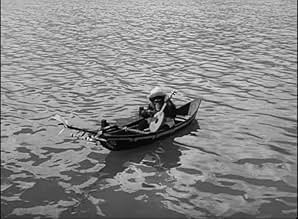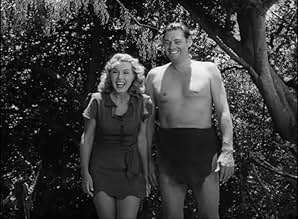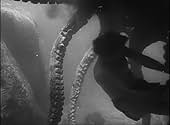To escape from an arranged marriage to Aquatania's pagan god, a desperate maiden ends up in Tarzan's fishing net. But soon, he, too, finds himself before a well-planned conspiracy. Can Tarza... Read allTo escape from an arranged marriage to Aquatania's pagan god, a desperate maiden ends up in Tarzan's fishing net. But soon, he, too, finds himself before a well-planned conspiracy. Can Tarzan save the mermaid from the barbaric idol's will?To escape from an arranged marriage to Aquatania's pagan god, a desperate maiden ends up in Tarzan's fishing net. But soon, he, too, finds himself before a well-planned conspiracy. Can Tarzan save the mermaid from the barbaric idol's will?
- Aquitanian
- (uncredited)
- Aquitanian
- (uncredited)
- Aquitanian
- (uncredited)
- Aquitanian
- (uncredited)
- Aquitanian
- (uncredited)
- Aquitanian
- (uncredited)
- Aquitanian
- (uncredited)
- Older Aquitanian
- (uncredited)
Featured reviews
This seemingly idyllic locale still has its drawbacks though: not only do the couple now have a really irritating new neighbour in the form of calypso-singing mail-man Benji (John Laurenz), but only a few short vine swings down the river, trouble is brewing in the taboo coastal realm of Aquatania, where a pair of wicked con artists (George Zucco and Fernando Wagner) are posing as living deity Balu to trick the locals out of a fortune in pearls. After giving refuge to a young Aquatican woman who has escaped from a forced marriage to the false god by swimming upriver, Tarzan decides that if he is ever going to get some well earned rest and relaxation (and judging by Weissmuller's haggard appearance, he really could do with some), he must first sort out the unrest in Aquatania (although personally I would begin by throttling Benji!).
The twelfth and final outing for Johnny Weismuller as Edgar Rice Burrough's ape-man, Tarzan and the Mermaids is easily the weakest of the whole series, with a star who looks like he's been partying way too hard between shooting (stubble and a paunch is not a great look), a poor script that favours musical numbers, lighthearted aquatic frolics, scenic panoramas over decent action and adventure, and a thoroughly unconvincing Mexican filming location (an Aztec temple, the unmistakable cliffs of Acupulco, and a supporting cast of Hispanic performers don't exactly give off that African vibe). Director Robert Florey's tepid direction does little to help matters, with even an attack by giant octopus proving to be a big disappointment.
Weissmuller enthusiasts will no doubt want to check out 'Mermaids' for the sake of completion, but be warned, this ain't a great way to end an era.
As for the story starting with a narration followed by ten minute character introductions, Mara (Linda Christian), a beautiful maiden from the forbidden island, is forced by the High Priest (George Zucco) to become an unwilling bride of a feared island "God" Varga (Fernando Wagner), a villainous pearl trader, although she actually loves the exiled Tiko (Gustavo Bojo). Mara escapes Aquantinia and swims to the location of Tarzan (Johnny Weissmiller) and Jane (Brenda Joyce) who agree to assist her. After Mara is found, she is abducted and taken back to her island. Tarzan and Jane follow, are held prisoners. Following their escape, Tarzan intends to unmask the false god and expose the white men after their priceless pearls before Mara's wedding is to take place. Also featured in the cast are Edward Ashley (Balu)and Andrea Palmer (Luana).
In spite the fact that TARZAN AND THE MERMAIDS, might have made Weissmuller's farewell performance into something special, its ordinary 68 minute storyline, which appears to have been revamped many times over the years, especially from the Maria Montez and Jon Hall South Seas adventures produced over at Universal through most of the 1940s, weakness dominates few of its strengths. Obvious changes were also being made at this time. Missing from the cast of regulars is Johnny Sheffield as Boy, who had outgrown his part. He is mentioned by Jane, as she writes a letter to him, to be attending school in England (a truant officer must have come for him after all these years in the jungle), leaving Tarzan and Jane with Cheetah to fill in the void. Along with the good and the not so good, this marks the first in the series since the early MGM days to be lensed on location rather than a closed set. Opening titles credit this with location scenes filmed in Acapulco and the studios at Churubusco and Mexico City, which is all well and good, but one would wonder why color photography wasn't an added factor to the expense of location scenes. Interestingly, the use of the footage lacks the substance of any indication of this being in Tarzan's native homeland of Africa. As for the featured players, George Zucco as the villainous high priest, is the only asset. One only wishes he had more scenes matching wits with Tarzan adding more interest to the story.
While the weakest in the series, TARZAN AND THE MERMAIDS shouldn't be classified as the worst. Lacking more action than usual, one of its main faults is not so much as adding new characters to the story, but the extensive use of a singing mailman, played by John Lorenz as Benji (no, not in the form of the famous dog). Not truly categorized as a musical, it consists of numerous songs to make it so, including such forgettable tunes as, "I'm Taking a Letter to My Friend, Tarzan," "Oh, Most Beautiful Mermaid," "Fairwell, Fair Mermaid," "Let Us Hasten to Adventure" and "I'll Serenade You With My Guitar." A pity Tarzan doesn't get his chance to serenade Jane in a canoe surrounded by swimming native girls, which might have worked as a very silly highlight, but for what it is, TARZAN AND THE MERMAIDS is so offbeat from its predecessors, lacking the standard use of animal stampedes, dangers setting place underwater (though there's a memorable cliff diving scene and added attraction of Tarzan fighting an octopus), the traditional Tarzan ape call, along with additional footage centered upon other actors bearing little or no interest to the viewer, of course with the exception of the characteristic Zucco.
Having played on commercial television since the 1960s as part of its "Tarzan" lineup, with the RKO Radio series never placed on video but onto DVD, TARZAN AND THE MERMAIDS was, along with the other "Tarzan" adventures, presented on American Movie Classics cable channel (1998-2000) before moving to Turner Classic Movies(TCM premiere: June 25, 2011). As specified, TARZAN AND THE MERMAIDS marked the end of an era for Weissmuller, who no longer was physically fit to appear in any more installments.
Considering his type-casting, he didn't end up collecting his unemployment check. Almost immediately, he found renewed success assuming the part as another jungle hero (fully clothed) in a brand new film series as JUNGLE JIM (1948 to 1955) for Columbia Pictures. Brenda Joyce would play Jane one more time for the next installment, TARZAN'S MAGIC FOUNTAIN (1949), introducing Lex Barker as the new (and younger) jungle man. (**1/2)
Not only had Weissmuller gotten too old for his role; Johnny Sheffield, the quintessential 'Boy', had grown to manhood (he was a strapping 17-year old), so he was written out of the script, under the pretext of being 'away at school'. Brenda Joyce, at 35, was appearing in her fourth of five films as 'Jane' (she would provide the transition when Lex Barker became the new Tarzan, in 1949's TARZAN'S MAGIC FOUNTAIN) and was still as wholesomely sexy as ever.
Produced by Sol Lesser, at RKO, on a minuscule budget, the cast and crew took advantage of cheaper labor by filming in Mexico. While the location gave a decidedly Hispanic air to what was supposedly darkest Africa, veteran director Robert Florey utilized the country extensively, incorporating cliff diving and an Aztec temple into the story.
When a young island girl (Tyrone Power's future bride, Linda Christian) is rescued in a jungle river by Tarzan, he learns that a local high priest (George Zucco, one of filmdom's most enduring villains) had virtually enslaved the local population, threatening retribution from a living 'God' if they don't do his bidding. The girl had been chosen to become the 'God's' bride, so she fled. Faster than you can say 'Is this a dumb plot or WHAT?', the girl is kidnapped by the priest's henchmen and returned to the island, and Tarzan, followed by Jane, colorful Spanish character 'Benjy' (charmingly played by John Laurenz, who sings several tunes), and a government commissioner are off to take on the Deity and his priest (poor Cheeta is left behind). After a series of discoveries (the 'God' is simply a con man in an Aztec mask, working with the priest in milking the island's rich pearl beds), a bit of brawling action, and comic relief and songs by Benjy, everything reaches the expected happy conclusion.
Remarkably, TARZAN AND THE MERMAIDS features a musical score by the brilliant film composer, Dimitri Tiomkin, and is far better than what you'd expect from this 'B' movie!
While the film would provide a less-than-auspicious end to Weissmuller's time in Tarzan's loincloth (he would immediately go on to play Jungle Jim, a more eloquent variation of the Ape Man, in khakis), the talent involved lifted the overall product at least a little above the total mess it could have been.
Tarzan was about to get a make over, and become much sexier...
Wherever Tarzan was from exactly in Africa in the Forties he kept running into more Africans who weren't black than those who were. In this film he's found himself a culture who worships the God, Baloo. Baloo in fact is a pearl trader Fernando Wagner who puts on a Baloo suit and with high priest George Zucco keeps the natives in line. Wagner wants pearls, but Zucco's got an eye for Linda Christian and Baloo says to her to marry with Zucco. But she likes Gustavo Rojo and in the end Tarzan has to straighten everyone out in his usual manner.
Brenda Joyce was Jane again, but Johnny Sheffield as Boy had departed the series going off to England for a neglected education. God only knows what that was like for the kid in an English public school. But Sheffield at least managed to miss some of the nonsense rampant in Tarzan And The Mermaids.
Don't get me wrong, it's great fun if you don't take it seriously.
Did you know
- TriviaThe absence of the Johnny Sheffield character "Boy" from this film is explained with the the claim that Boy is "away at school." In truth, Sheffield's RKO contract had not been renewed, and the actor then signed a deal with "Poverty Row" studio Monogram Pictures to make a series of movies as "Bomba," a character clearly intended to evoke memories of Sheffield's many appearances in Tarzan films.
- GoofsTarzan wears shoes in this movie, and the shoes have the ability to appear and disappear between shots. When he goes after Mara and her kidnappers, he has on what appear to be sandals. During the times he is in the cave, the shoes appear and disappear. Later on, when Tarzan is attacked by an octopus, he has no shoes on, and after he kills it, the shoes are back on his feet.
- Quotes
Palanth, the High Priest: If my people knew anyone posed as Balu, they would destroy him.
Tarzan: If people know Balu a man, they destroy you!
- ConnectionsFeatured in Buster and Billie (1974)
- SoundtracksI'm Taking a Letter to My Friend, Tarzan
(uncredited)
Written by Sir Lancelot
Played on guitar and Sung by John Laurenz
- How long is Tarzan and the Mermaids?Powered by Alexa
Details
Box office
- Budget
- $1,000,000 (estimated)
- Runtime1 hour 8 minutes
- Color
- Aspect ratio
- 1.37 : 1
Contribute to this page






























